System Synthetics is the third winning project of the Designers & Artists 4 Genomics Award (see also 2.6g 329m/s, aka the ‘bulletproof skin’ and The Microscopic Opera.) The first edition of competition, launched by the Waag Society with the Netherlands Genomics Initiative and the Centre for Society and Genomics invited emerging artists and designers to submit projects involving the exploration of biotechnology.
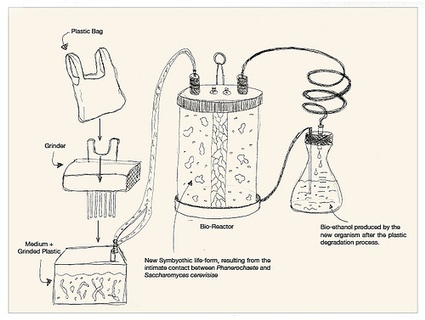
Designer Maurizio Montalti is teaming up with the Kluyver Centre for Genomics of Industrial Fermentation to work on an alternative to fossil fuels. He aims to build a transparent bioreactor that will allow the public to see how one fungus breaks down plastic and the other fungus makes bio-ethanol out of it.
Hi Maurizio! This is not the first time that you are working with fungi. Can you tell us a few words about your previous project, Continuous Bodies? I am particularly interested to hear more about The Ephemeral Icon. Is the Bio Cover ‘tool-product” you present in this project functioning already?
Exactly, you’re right. My fascination for these astonishing organisms already started before, and culminated in one of my last works, titled Continuous Bodies; in that investigation I’ve been looking at physical decay and physical death as natural processes, without which there could be no new life. The project originated as a reaction to the prevalent attitude of denial which usually characterizes people when it comes to be confronted with the loss of a beloved. In order to try and change this attitude I placed my focus towards a better understanding of the realm of fungi and at their fundamental importance in the environment with regard to decomposition and transformation of both organic and inorganic substrates and the resultant cycling of elements; this offered me the opportunity to try and re-qualify the general perception of the public in relation to these organism, usually associated with feelings of disgust and repulsion.
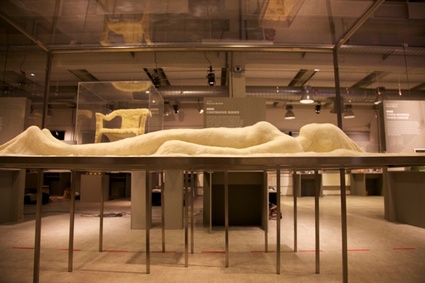 Continuous Bodies, cycles of decomposition triggering a symbiotic partnership between humans and fungi, 2010
Continuous Bodies, cycles of decomposition triggering a symbiotic partnership between humans and fungi, 2010
Envisioning alternative possibilities, while questioning different attitudes related to modern human culture and “development” allowed me to highlight some of the potential extended benefits that fungi could provide us. By getting more and more familiar with this organisms, directly experimenting with them and widely diving into the scientific literature, I got in touch with the ability of a specific fungus (Phanerochaete chrysosporium) in literally feeding on every kind of plastic, even the toughest ones (e.g. polycarbonate, phenolic resins and so on…); this created the basis for the development of the second part of ‘Continuous Bodies’, titled The Ephemeral Icon.
The main drive, concerning this part, has been the possibility of neutralizing synthetic materials that do not naturally decompose and that are found to provoke unhealthy, risky consequences for both the human being and for the entire ecosystem.
 Bio-cover, 2010
Bio-cover, 2010
Merging this finding with a vision allowed me to create a social narrative to help us questioning our “throw away” culture, while exploiting, in a beneficial way, the resources that this social behaviour created. In order to translate my overall research and address issues related to disposability, plastic toxicity, and the possibility of having fungi being able to “kill” this immortal materials, i focused my attention on a globally well-known iconic object: the plastic monobloc chair. I use this chair as a statement about the life-cycles of consumer products in comparison with the immortality of the materials, most of the consumer products are made of. Highlighting the complementarity of life and death as a whole, with my design, the Bio-Cover, i play with the idea of infusing life in a dead everlasting material, in order to trigger a process of final dissolution. At this time, the duration of this process is quite long (but still good if compared to millennia) and takes place in standard lab conditions (sterile environment and specific set of parameters in relation to temperature, humidity and so on.); this because this finding is still very young and in need of further explorations regarding the optimal conditions in which the process would develop more efficiently in the ‘real world’.
Nevertheless, by performing different tests with the fungus on plastic material, one of them ended up being luckily successful, as I’ve been able to achieve the complete degradation of plastic samples (acrylic rings) in less than ten months.
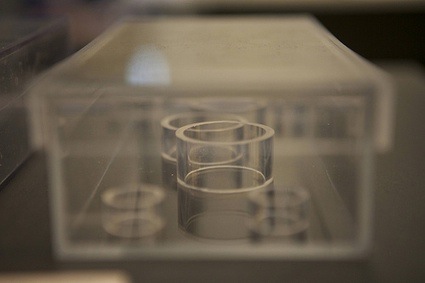 Plastic degradation experiment – before
Plastic degradation experiment – before
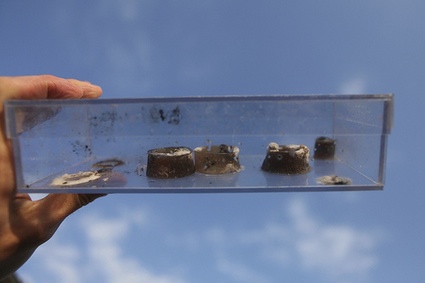 Fungus eating plastic – Middle process
Fungus eating plastic – Middle process
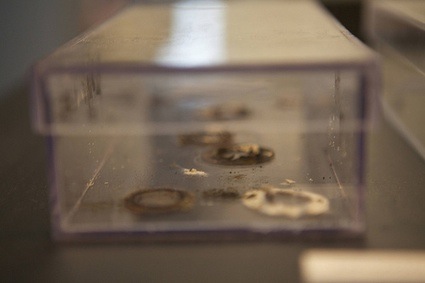 Plastic degradation experiment – after
Plastic degradation experiment – after
How much does the research you made for Continuous Bodies inform System Synthetics? Do you see this new project as a natural extension of CB? Do you feel you are ready to tackle your new ambitious project based on what you’ve learnt with CB? Or do you have to start almost from scratch because the fungus you are going to use in the new project is entirely different from the ones you worked with in the past?
You could say ‘System Synthetics’ comes as a direct continuation to my previous work; but i would rather say it’s an ‘evolution’ of it. However it looks at something different; if, on a side, it still tries to develop a practical research to show the important contribute that micro-organisms do have in our existence, on the other side it raises new questions and aspires to promote a discussion about a man-made evolution of life.
The possibility of improving the performance of a natural organism (in this case a fungus) to face the consequences of the human indiscriminate action on our ecosystem, is a valid enough reason to give a start to this new potential vast territory of research; i strongly believe, in fact, that we humans, should start recognizing how important it is to team up with other species and organisms and establish with them a symbiotic relationship.
Moreover at the core of my project lies the (unusual) idea of combining the abilities of two
organisms which belong to the same kingdom: one fungus (Phanerochaete chrysosporium) and one yeast (Saccharomyces cerevisiae), so to create an intimate man-made endo-symbiosis between two fungi in which the capacities to degrade plastics and to produce bio-ethanol are intertwined.
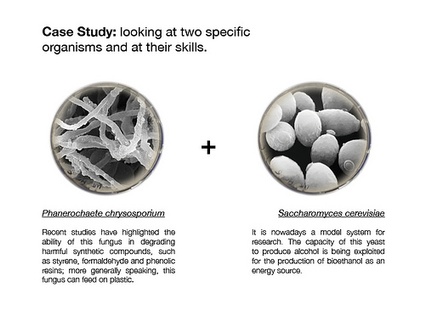
The previous experience in the lab is for sure an important advantage to me, to tackle this new ambitious project; this because I already had the possibility to get familiar with different micro-biological techniques in the study of fungal behaviour and to directly test my hypothesis with a “hands-on” approach. However there’s much more to learn and that’s what makes this whole project so exciting.
The fungus I’m going to use is the same I’ve been previously working with, but for instance I never worked before with yeasts (if not for making pizza dough…!) and also, some of the techniques and methodologies that I will adopt in this new process will be for me a totally new discovery and a possibility of gaining new knowledge.
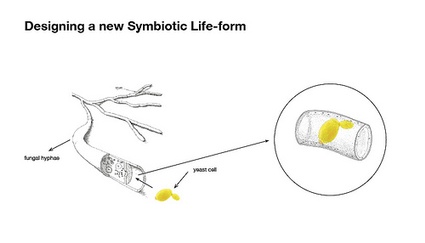 Fungus – yeast, symbiosis sketch
Fungus – yeast, symbiosis sketch
The press release states that your project aims to develop a “publicly accessible transparent bioreactor”. does this formula means that the technology to do it will be available for the broad public to replicate the process and produce fuel at home?
Not really, but hopefully in a not-so-distant future, yes.
I say this because the path I’m starting with this project could be a long one. In these next five months I will create a design of the architecture of the symbiosis of Phanerochaete chrysosporium and Saccharomyces cerevisiae. This design will be integrated with a tailor-made bioreactor, resulting in a set-up that efficiently would convert plastic into bio-ethanol. The implementation of the design of the new symbiotic life-form could probably take many years of research. I will contribute to this process by defining the conditions under which Phanerochaete chrysosporium and Saccharomyces cerevisiae can co-exist. Moreover I will label the partners with fluorescent proteins, in order to make the interaction between the two organisms clearly visible to the public.
The bio-reactor will be built from transparent materials, allowing the viewer to monitor the complete process. For instance, within the bioreactor the new life-form will be visible.
The viewer will witness that the machine operates autonomously, using part of the produced bio-ethanol as source of energy and having as only input the plastic waste. A process film, documenting all the main relevant experiments in the labs, together with visual materials, will complete the exhibition.
The results of the competition have been announced last month. Have you already started working on System Synthetics? How is the collaboration with Kluyver Centre for Genomics of Industrial Fermentation taking shape? Are they mostly your consultant when you need some feedback about the most scientific details or do you have a more symbiotic relationship with them? Do you work at their venue for example?
Yes, absolutely. I already started working on my project, mainly by preparing the first cultures of the two selected organisms and organizing the different phases and experiments of these next months; this together with the Kluyver Centre. Of course the whole planning could get re-shaped in the course of the next months, according to the results that I will achieve during the process.
Also I had the possibility of being given a personal working space within the lab, as I’ll be present in there most of the time, not only for documentation purposes; i’ll be directly responsible for performing the whole experimental part, with the assistance of a small team, which will naturally give me the needed operational instructions for the achievement of a successful outcome.
The process will develop, in any case, on the base of a regular consultation with the leader of the ‘Filamentous Fungi’ group at the Kluyver Centre, Prof. Han Wosten, with which I feel I already established a strong symbiotic
relationship. Looking forward to taking the next steps…
Thanks Maurizio!
All images courtesy: the designer.
